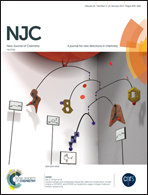Studies on neptunium complexation with CMPO- and diglycolamide-functionalized ionic liquids: experimental and computational studies†
Abstract
The complexation of neptunium in its 4+ and 6+ oxidation states was investigated using two task-specific ionic liquids (TSIL), namely, CMPO (carbamoylmethylphosphine oxide)-TSIL (LI) and DGA (diglycolamide)-TSIL (LII), respectively, using liquid–liquid extraction, UV-vis spectroscopy and DFT calculations. The extraction of both Np4+ and NpO22+ ions was found to follow a cation-exchange mechanism and the extracted species contained one TSIL unit per metal ion, as well as nitrate ions and water, as indicated by the slope analysis method. LI resulted in higher complex formation constants than LII in spite of the possible tridentate nature of the complexes in the latter case. Thermodynamic parameters were determined, which could explain the nature of the extracted species. The facile stripping of the extracted metal ions suggested the possible reusability of the solvent systems. UV-vis spectroscopic studies showed an entirely different mode of complexation of the extracts in LI and LII in comparison to that in n-dodecane, which confirmed a different extraction mechanism. Computational studies were carried out to obtain optimized structures of the complexes, which included nitrate ions and water molecules in the inner coordination sphere.



 Please wait while we load your content...
Please wait while we load your content...